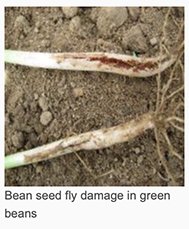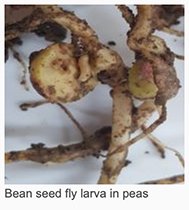CROP UPDATE NO 4 - BEAN SEED FLY (DELIA PLATURA) - 9 APRIL 2019
As part of The Horticulture Strategic Centres for Field Vegetables, funded by AHDB with co-funding from NIAB, ADAS, PGRO and Duchy College, we seek to provide, with the help of growers, information about the distribution of the bean seed fly (Delia platura) across the UK in all affected crops.
Bean seed fly affects more than 40 different host plants and is an important pest of peas, maize and beans. Hosts include Phaseolus beans, peas, broad beans, cucumber, melon, spinach, onion, pepper, potato, maize (alfalfa, cotton, strawberry and tobacco are secondary hosts) and the larva is a common pest found in most temperate countries.
In severe infestations plant loss at seedling stage may be high, often resulting in re-drilling and loss of production of high value crops at an early growth stage.
Bean seed fly has been identified as a high priority for UK vining peas, picking peas and Phaseolus beans (green and runner beans), as well as in alliums, asparagus and leafy salads, due to increasing incidents of damage, the loss of key active insecticidal substances and the increased use of cover crops in rotations.
To help map the distribution of bean seed fly, PGRO have developed a section within the PGRO App in which growers and agronomists can record the incidence of bean seed fly larvae in any crop.
The PGRO App is available from Apple and Google Stores – search for PGRO Pea and Bean Guide.
The link to the bean seed fly recording page is shown on the opening page of the app, so click on bean seed fly and select the crop type that you’re growing or working with. If the crop is not a legume crop, select ‘other crops’. As you follow the links you will reach the page where you can create a report, and here you can enter the farm name, field name and any additional notes you have about crop type, level of infestation or damage. You can add photos to the report, and it will geolocate you if you’re able to provide the report from in-field, or you can add a postcode if you’re reporting the pest from your office. The data will be used only for the purposes of the project and the report will be visible at http://pgroapp.org/. No personal data will be published.
Adult flies are attracted to freshly disturbed soil containing debris from previous crops, high levels of organic matter such as farmyard manure, or weed debris. Eggs are laid on the soil surface and larvae hatch after a few days and feed on newly planted seeds or plant and crop debris. After 10-14 days, larvae pupate and emerge as a second generation of flies, which move to suitable feeding sites. There may be several overlapping generations per year, occurring from late spring until early autumn. Seed of later planted peas or beans is attacked during germination and larvae feed on newly planted seeds and seedlings, tunnelling into freshly imbibed seeds and the stems of small seedlings.





